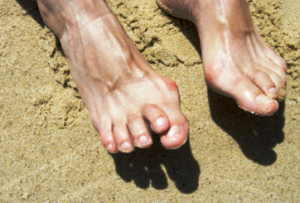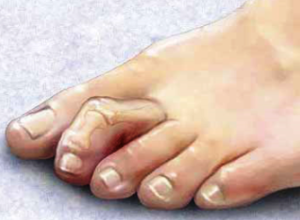Hammer toes
Hammer toes/Claw toes
Hammer toe, claw toes and mallet toes are common occurring lesser toe deformities. A hammertoe is a bending of one or both joints of the second, third, fourth, or fifth (little) toes. This abnormal bending can put pressure on the toe when wearing shoes, causing problems to develop.
Hammer toes usually start out as mild deformities and get progressively worse over time. In the earlier stages, hammer toes are flexible and the symptoms can often be managed with non-surgical measures. But if left untreated, hammertoes can become more rigid, cross over other toes reducing the effect of conservative treatment.
Symptoms
The bending of the toes can cause your toes to dig into the soles of your shoes forming painful calluses and corns either on the toe or the balls of the feet. Some other symptoms include;
- Pain or irritation of the shoe when wearing shoes.
- Corns and calluses.
- Inflammation or a burning sensation.
- Possible numbness.
- Footwear difficulties.
- Upwards bending of toes – toes overlapping each other.
Cause
The most common cause of hammertoe is due to an imbalance between a muscle/tendon. This imbalance can be as a result of particular foot types (flat feet and high arch feet). This leads to a bending of the toe/s as a result from mechanical (structural) changes in the foot that occur over time in some people. Hammer toes may be aggravated by shoes that don’t fit properly. A hammer toe may result if a toe/s is too long and is forced into a cramped position when a tight shoe is worn. Some other causes of hammer toes are;
- Bunions – pressure from a bunion pushing onto the second toe causing a hammer toe and occasionally the second toe rising and overlapping the bunion.
- Hereditary/genetics.
Treatment
Preventing hammer toes from occurring is the most effective treatment for lesser toe deformities. Such preventative measures include;
- Avoid wearing tight or narrow shoes (make sure shoes are not short – thumb space from your longest toe – not always your big toe!).
- Avoid high heel shoes.
- If you have a wide foot wear wide fitting shoes.
Conservative treatment offered at Sydney Foot Clinic for lesser toe deformities (hammer/claw/mallet) include;
- Removing calluses and corns – a podiatrist is trained to remove calluses and corns in a safe manner.
- Prescription of custom made orthotics – orthotics are designed to guide the posture/mechanics of the foot, reduce pressure at the lesser toe deformities and help control muscle/tendon imbalance.
- Splinting – some hammer toes can be splinted to help reduce the deformities.
- Padding the foot – padding can redistribute pressure from the ball of your foot.
- Footwear recommendations.
- If conservative treatment fails, surgery may be needed to reduce rigid and symptomatic hammer toes.
